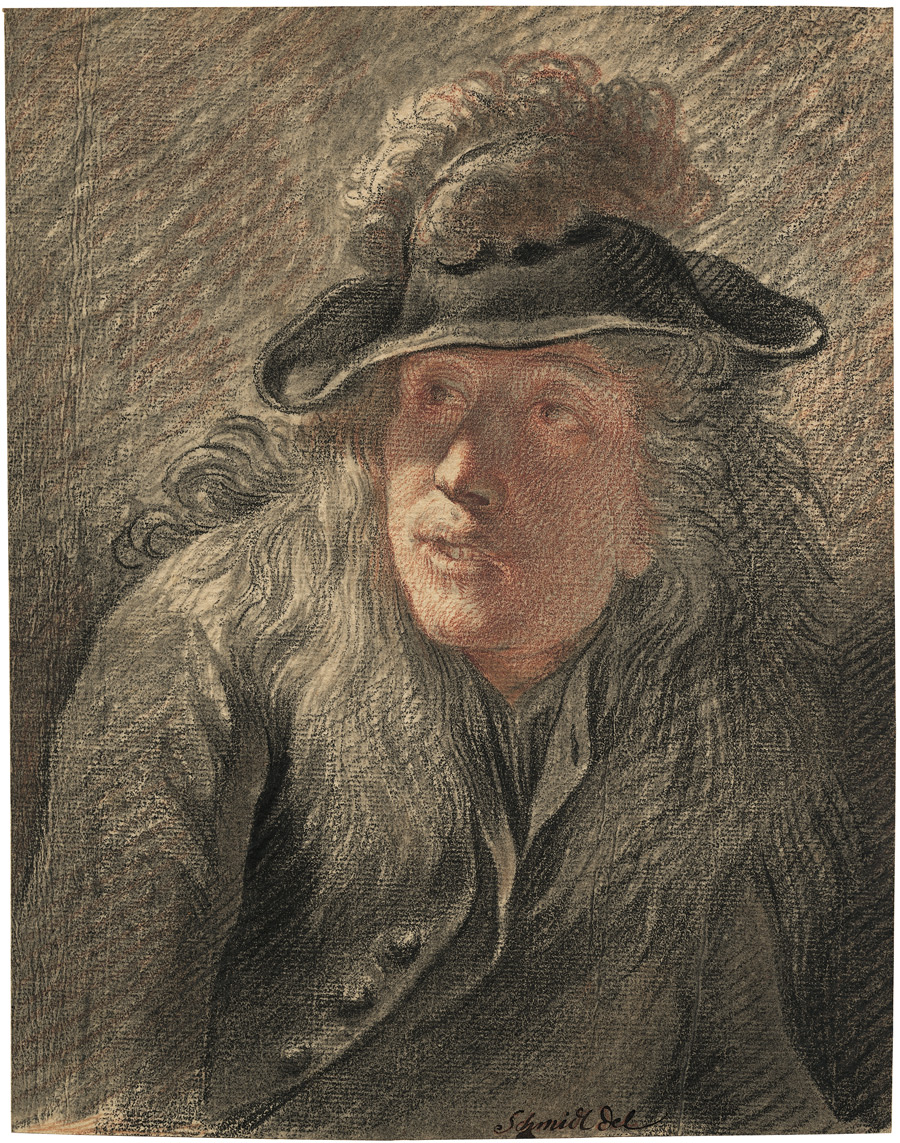Loading the page ...
Georg Friedrich Schmidt
(1712 Schönerlinde b. Berlin - 1775 Berlin)
Half-length Portrait of a Young Man with Plumed Hat and Long, Flowing Hair. Black and red chalk, grey wash. 25.2 x 19.8 cm. Inscribed in pen and black ink: Schmidt del.
The young man with the long tangled hair and the jaunty little plumed hat makes an almost droll impression that is reinforced by the hunched shoulders. His mouth is half open, his eyes have a surprised, almost startled look, while his head, which is turned to the left, seems disproportionately large in comparison to the slender, slightly twisted torso. This swiftly and accurately sketched drawing convincingly renders the personality of the man portrayed and owes its appeal to its immediacy and lifelike character. Schmidt arouses the curiosity of the beholder, stirring a wish to know more about this enigmatic person. In his very subjective and intimate rendering of the subject Schmidt reveals the depth of his inspiration by such great predecessors as Castiglione and, above all, Rembrandt, to whose art he felt particularly drawn. The apparent spontaneity of the portrait conceals an accomplished draughtsman. The details of the clothing and hair are sparingly indicated in black chalk while the soft wash enhances the texture of the fabrics. Powerful, sweeping cross-hatching enlivens the background. In an effective contrast Schmidt has minutely detailed the face, which stands out starkly against the dark background, the red chalk giving its complexion an almost vibrant warmth. Bright patches of light on the tip of the man’s nose and around his mouth, which are achieved by a skilful use of the white paper tone, intensify the liveliness of this evocative portrait.
Drawings like this were doubtless intended as works of art in their own right. Schmidt made several of these sensitively observed portraits with the evident aim of capturing the character or mood of the subjects in as lifelike a manner as possible (cf. H. Tietze, E. Tietze-Conrat, Otto Benesch et al., Beschreibender Katalog der Handzeichnungen in der Graphischen Sammlung der Albertina. Die Zeichnungen der deutschen Schulen bis zum Beginn des Klassizismus. Vienna 1934, vol. IV, p. 145, no. 1774; vol. V, plate 271, no. 1774; T. Gaethgens, V. Manuth, B. Paul (eds.), Deutsche Zeichnungen des 18. Jahrhunderts zwischen Tradition und Aufklärung, Berlin 1987, p. 83, no. 37). Schmidt’s interest in character portrayals was doubtless also inspired by the art theories of his day. The artist’s refined combination of different coloured chalks betrays the influence of contemporary French models. From 1737 to 1743 Schmidt had lived and worked in Paris, where he associated with such artists as Nicolas de Larmessin and Hyacinthe Rigaud. He was a friend of Johann Georg Wille, whose style he emulated in quite a few of his portrait drawings. Despite his Protestant origins Schmidt was even admitted to the Académie Royale by royal command in May 1742. After spending several years in St. Petersburg, Georg Friedrich Schmidt lived the rest of his life in Berlin.
On an 18th century mount. Inscribed in pencil: "Schmidt aus Börners Nachlaß" (Johann Andreas Boerner, 1785–1862, Nuremberg; Lugt 269–270). The drawing is a significant and rare testimonial to German drawing in the age of Frederick the Great.
